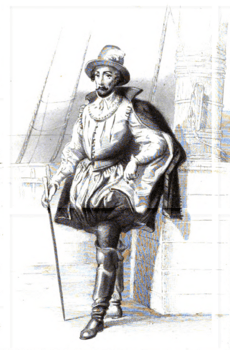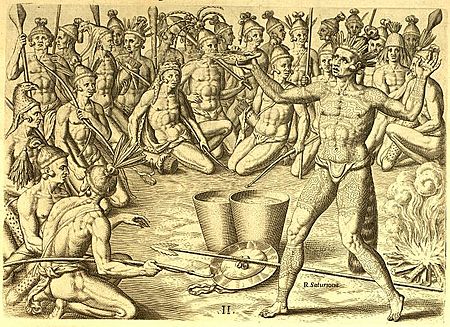René Goulaine de Laudonnière facts for kids
Rene Goulaine de Laudonnière (born around 1529, died 1574) was a French explorer. He was a Huguenot, which means he was a French Protestant. Laudonnière is famous for starting the French colony of Fort Caroline. This colony was in what is now Jacksonville, Florida. A French leader named Admiral Gaspard de Coligny sent Laudonnière and Jean Ribault to Florida. Their mission was to find good places for French Protestants to live.
Contents
Early Life and First Voyage
Rene Laudonnière was a nobleman and a sailor from France. We do not know much about when he was born or his family.
In 1562, Laudonnière became second-in-command of a French expedition. This group of Huguenots went to Florida with Jean Ribault. They left France in February 1562. They returned home in July after setting up a small settlement. This place was called Charlesfort in what is now South Carolina.
Starting Fort Caroline
After the first trip, wars started in France. These were the French Wars of Religion between French Catholics and Protestants. Ribault had to leave France. Laudonnière was then put in charge of a new trip to Florida.
In 1564, King Charles IX gave Laudonnière money. He returned to Florida with three ships and 300 French settlers.
Arrival in Florida
Laudonnière arrived at the mouth of the May River on June 22, 1564. Today, this river is called the St. Johns River. He sailed up the river and found a good spot. Here, he built Fort Caroline. They named it after King Charles. This fort was in what is now Jacksonville.
He met the Saturiwa people. They were a group of Timucua Native Americans. They were friendly to the French settlers. They even showed Laudonnière a special monument. This monument had been left by Ribault on his earlier trip.
Challenges at the Colony
Life at Fort Caroline was hard. The colony did not grow well. The settlers had to get food from the Timucua people. Some colonists complained about the hard work. Laudonnière sent them back to France.
Some settlers left the colony and became pirates. These deserters made the Timucua angry. The Timucua then stopped giving food to the colonists. The settlers had to eat acorns and roots. Finally, some colonists rebelled against Laudonnière.
Spanish Attack and Escape
On August 3, 1565, Laudonnière bought food and a ship. He got them from a passing English privateer named John Hawkins. Laudonnière planned to take the colonists back to France.
While he waited for good winds, Jean Ribault arrived. Ribault came with 600 more settlers and soldiers on September 10. Ribault told Laudonnière that he was now in charge. Ribault offered to share power, but Laudonnière decided to go back to France.
The Spanish Arrive
Events changed Laudonnière's plans. A Spanish fleet appeared, led by Pedro Menéndez de Avilés. Spain had long claimed Florida. This claim was based on the voyage of Juan Ponce de León in 1513. King Philip II of Spain sent Menéndez to remove the French Protestants from Florida.
Menéndez tried to attack Ribault's ships near the St. Johns River. But the sea conditions made it impossible. The Spanish admiral sailed about 40 kilometers south. He landed his troops on August 28, 1565. They quickly built defenses near a Timucua village called Seloy. This place is now St. Augustine.
Ribault decided to attack the Spanish. He sailed south on September 10, taking most of the soldiers. He left Laudonnière with 100 men, but only 20 were soldiers.
During a hurricane, Menéndez marched his Spanish troops north. They walked about 40 kilometers to attack Fort Caroline. On September 20, they surprised the French fort. The Spanish killed most of the men, about 140. About 60 women and children were saved.
Laudonnière and 40 to 50 others managed to escape. He reached the river's mouth. Ribault's son was there with three ships. Laudonnière sailed with him for a while. Then he went home on his own ship. He unexpectedly landed in Wales.
Fate of Ribault's Men
Meanwhile, Jean Ribault's fleet was hit by the same hurricane. The storm pushed the French ships many miles south. They ended up near what is now Daytona Beach. All the warships were destroyed.
Ribault and hundreds of other survivors washed ashore. They started walking north along the beach. At Matanzas Inlet, a Spanish patrol found them. The Spanish took them prisoner. Following the King of Spain's orders, most of the French Protestants were killed. A few Catholics and young musicians were spared. Ribault was also killed, along with about 350 of his men. By mid-October 1565, France's military power in Florida was gone.
Later Life and Memoirs
Laudonnière traveled through Bristol and London. He likely reached Paris in December 1565. After reporting to the royal Court, Laudonnière disappeared from historical records for a while.
Several years later, in 1572, he appeared as a merchant sailor. He was in La Rochelle. He managed to avoid the St. Bartholomew's Day Massacre of Huguenots. He died in Saint-Germain-en-Laye in 1574. His book, L'histoire notable de la Floride, was published in 1586. It told the story of the three French trips to Florida.
See also
 In Spanish: René Goulaine de Laudonnière para niños
In Spanish: René Goulaine de Laudonnière para niños




